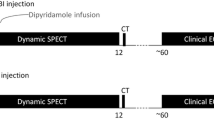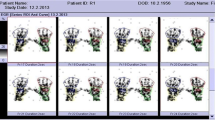Abstract
201Tl perfusion scintigraphy of the legs was evaluated to define intermittent claudication quantitatively, based on Sapirstein's indicator fractionation principle. After intravenous injection of 201Tl with or without exercise, the distribution of the radiotracer throughout the body was obtained using the whole body scanner. Regional blood flow of cardiac output for three segments of the leg was estimated as a regional fractional uptake (rFU) distributed in these segments compared with the whole body distribution. The validity of the principle was confirmed by a comparative study with 99mTc-MAA (r=0.979). Normal rFUs (%) for each section at rest and after stress, respectively, were 5.49±0.69 and 19.40±2.04 (whole leg); 3.57±0.49 and 12.26±1.91 (thigh); 1.59±0.34 and 6.58±0.61 (calf). The rates of rFU change from the state of rest to stress (ΔrFU) in normals were 3.41±0.45 (whole leg), 3.44±0.61 (thigh), and 4.30±1.03 (calf). Although rFU was within normal limits in patients with arteriosclerosis obliterans (ASO) and thromboangitis obliterans (TAO), ΔrFU of the whole leg was significantly decreased from the normal value of 3.41±0.45 to 1.95±0.40 for ASO (P(0.001) and 1.82±0.47 for TAO (P(0.001). A defect or decreased activity on the stress scintigraph was well correlated with the angiographic findings.
Similar content being viewed by others
References
Alpert JS, Larsen O, Lassen NA (1969) Exercise and intermittent claudication blood flow in the calf muscle during walking studies by the xenon-133 clearance method. Circulation 39:353–359
Christensen J, Larsson I, Svensson S-E (1977) Distribution of intravenously injected 201Thallium in the legs during walking. Eur J Nucl Med 2:85–88
Ishi Y, MacIntyre WJ, Pritehard WH (1973) Measurement of total myocardial blood flow in dogs with 43K and the scintillation camera. Circ Res 33:113–122
Lassen NA (1964) Muscle blood flow in normal man and in patients with intermittent claudication evaluated by simultaneous 133Xe and 24Na clearance. J Clin Invest 43:1895–1812
Lassen NA, Lindberg RT, Munck O (1964) Measurement of blood flow through skeletal muscle by intramuscular injection of 133Xe. Lance 1:686–689
Lindbierg IF (1965) Measurement of muscle blood flow with 133Xe after histamine injection as diagnostic method in peripheral arterial disease. Scand J Clin Lab Invest 17:271–380
Sapirstein LA (1958) Regional blood flow by fractional distribution of indicators. Am J Physiol 193:161–168
Seder JS, Botvinick EH, Pahimtoola SH (1981) Detecting and localizing peripheral arterial disease: Assessment of 201Tl scintigraphy. ASR 137:373–380
Siegel ME, Giargiana FA Jr, Rhodes BA (1973) Effect of radioactive hyperemia on the distribution of radioactive microsphere in patients with peripheral vascular disease. AJR 118:814–819
Siegel ME, Siemsen JK (1978) A new noninvasive approach to peripheral vascular disease: Thallium-201 leg scans. AJR 131:827–837
Siegel ME, Stewart CA (1981) Thallium-201 peripheral perfusion scans: Feasibility of single-dose, single-day, rest and stress study. Am J Roentgenol ASR 136:1179–1883
Siegel ME, Wagner HN Jr (1976) Radioactive tracers in peripheral vascular disease. Semin Nucl Med 6:253–278
Stauss HW, Harrison K, Langes JK (1975) Thallium-201 to regional myocardial perfusion. Circulation 51:641–645
Strauss W, Harrison K, Pitt B (1977) Thallium-201: Non-invasive determination of regional distribution of cardiac output. J Nucl Med 18:1167–1170
Wagner HN, Jones E, Tow DE (1965) Preliminary note: A method for the study of the peripheral circulation in man. J Nucl Med 6:150–154
Weich HF, Strauss W, Pitt B (1977) The extraction of thallium-201 by the myocardium. Circulation 56:188–191
Yonekura Y, Ishii Y, Torizuka K (1980) Quantiative assessment of myocardial blood flow by measurement of fractional myocardial uptake of 201Tl. Kaku Igaku 17:1211–1220
Author information
Authors and Affiliations
Rights and permissions
About this article
Cite this article
Hamanaka, D., Odori, T., Maeda, H. et al. A quantitative assessment of scintigraphy of the legs using 201Tl. Eur J Nucl Med 9, 12–16 (1984). https://doi.org/10.1007/BF00254343
Received:
Accepted:
Issue Date:
DOI: https://doi.org/10.1007/BF00254343




